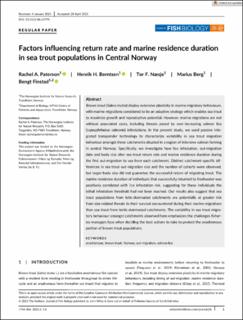| dc.contributor.author | Paterson, Rachel | |
| dc.contributor.author | Berntsen, Johan Henrik Hårdensson | |
| dc.contributor.author | Næsje, Tor | |
| dc.contributor.author | Berg, Marius | |
| dc.contributor.author | Finstad, Bengt | |
| dc.coverage.spatial | Norway | en_US |
| dc.date.accessioned | 2021-05-27T07:55:21Z | |
| dc.date.available | 2021-05-27T07:55:21Z | |
| dc.date.created | 2021-05-26T12:55:35Z | |
| dc.date.issued | 2021 | |
| dc.identifier.issn | 0022-1112 | |
| dc.identifier.uri | https://hdl.handle.net/11250/2756534 | |
| dc.description.abstract | Brown trout (Salmo trutta) display extensive plasticity in marine migratory behaviours, with marine migrations considered to be an adaptive strategy which enables sea trout to maximize growth and reproductive potential. However, marine migrations are not without associated costs, including threats posed by ever-increasing salmon lice (Lepeophtheirus salmonis) infestations. In the present study, we used passive integrated transponder technology to characterize variability in sea trout migration behaviour amongst three catchments situated in a region of intensive salmon farming in central Norway. Specifically, we investigate how lice infestation, out-migration date and body size alter sea trout return rate and marine residence duration during the first out-migration to sea from each catchment. Distinct catchment-specific differences in sea trout out-migration size and the number of cohorts were observed, but larger body size did not guarantee the successful return of migrating trout. The marine residence duration of individuals that successfully returned to freshwater was positively correlated with lice infestation risk, suggesting for these individuals the lethal infestation threshold had not been reached. Our results also suggest that sea trout populations from lotic-dominated catchments are potentially at greater risk from size-related threats to their survival encountered during their marine migrations than sea trout from lentic-dominated catchments. The variability in sea trout migratory behaviour amongst catchments observed here emphasizes the challenges fisheries managers face when deciding the best actions to take to protect the anadromous portion of brown trout populations. anadromous, brown trout, Norway, out-migration, salmon lice | en_US |
| dc.language.iso | eng | en_US |
| dc.rights | Navngivelse-Ikkekommersiell 4.0 Internasjonal | * |
| dc.rights.uri | http://creativecommons.org/licenses/by-nc/4.0/deed.no | * |
| dc.subject | anadromous | en_US |
| dc.subject | brown trout | en_US |
| dc.subject | Norway | en_US |
| dc.subject | out-migration | en_US |
| dc.subject | salmon lice | en_US |
| dc.title | Factors influencing return rate and marine residence durationin sea trout populations in Central Norway | en_US |
| dc.type | Peer reviewed | en_US |
| dc.type | Journal article | en_US |
| dc.description.version | publishedVersion | en_US |
| dc.rights.holder | © 2021 The Authors. | en_US |
| dc.subject.nsi | VDP::Zoologiske og botaniske fag: 480 | en_US |
| dc.subject.nsi | VDP::Zoology and botany: 480 | en_US |
| dc.source.journal | Journal of Fish Biology | en_US |
| dc.identifier.doi | 10.1111/jfb.14770 | |
| dc.identifier.cristin | 1911962 | |
| dc.relation.project | Andre: Møre og Romsdal fylkeskommune | en_US |
| dc.relation.project | Egen institusjon: Norwegian institute for nature research (NINA) | en_US |
| dc.relation.project | Andre: Fylkesmannen i Møre- og Romsdal | en_US |
| dc.relation.project | Andre: Norwegian Environment Agency | en_US |
| dc.relation.project | Andre: Det Norske Veritas | en_US |
| cristin.ispublished | true | |
| cristin.fulltext | original | |
| cristin.qualitycode | 1 | |

